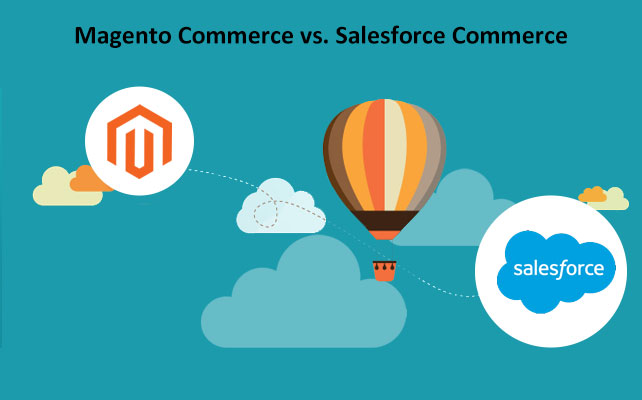
Magento and Salesforce are both popular and widely used customer relationship management services providing the best E-Commerce platforms and are used for various tasks like application development, analytics, automation and other Software associated tasks.
In this article, we are going to compare the latest version and features of both platforms.
Let’s discuss the key strengths of these platforms.
Salesforce
- It is a Software as a Service based platform, it offers a fully managed (we can configure it on different levels) multi-tenant platform to platform maintenance. Servers, infrastructure, security
- patching, upgrades etc., are all managed by Salesforce itself. Provides very strong merchandising facilities.
- Its new page designing solution is designed better to control the content and template to the merchants.
- Provides one-to-one level personalization, and with the help of machine learning tools like commerce Insights and Einstein, it provides useful insights.
- Highly capable of managing complex data of products, multiple product catalogues and price books.
- Powerful omnichannel features like order management and endless aisle
- On-demand A/B testing feature helpful in merchandising
- Native Support for internationalization (native currencies, multiple languages etc.)
Magento
- Very Powerful, built-in capabilities for multi-store with no additional cost, which is suitable for B2B, wholesale, multi-brand and international business
- Powerful in-built features for B2B and wholesale (which have improved with the launch of version 2.2)
- Highly scalable and highly customizable, which makes it differ from other SaaS platforms
- A very nice ecosystem for developers and partners to improve the platform
- It is considered the most mid-market focused e-commerce platform.
- Integrated content management tools like page builder come with the 2.2 version of Magento.
Summarising these points, we can say that Magento is a powerful, scalable e-commerce platform with lots of built-in capabilities for merchandising and managing multiple stores with Support for internationalization on lingual and currency level, B2B and customer clustering. With the new version of Magento comes the Page Builder, a powerful content management tool, a BI suite named Magento Bi, a visual merchandising tool, content scheduling and staging. It is far more capable when compared to the B2B solutions. Its new order management suite is highly capable, and it is separate from the e-commerce platform. It allows multi-site inventory management.
Salesforce commerce cloud has competitive offerings in all these areas, and with no doubt, we can say it is stronger in native features for merchandising and personalization. Also, its omnichannel functionalities for order management, endless aisle etc., are excellent. Furthermore, it provides very cool features like A/B testing, which help shape merchandising logic, promotional activities etc. Although fashion brands mostly use it, its features like advanced merchandising and endless aisle happen to be very suitable for lifestyle and fashion brands.
Coming to the cost for scaling and extension, the Magento Platform is cheaper than Salesforce. At the same time, Salesforce has a more powerful set of native features and better customization support. The cost in Magento is very static, while in Salesforce, it is calculated using the GMV model, and there are penalties too.
Talking about Scalability, Salesforce is still better than Magento, as proven by the past years. The Magento 1 had some issues regarding the scalability, which were considerably reduced in version 2. But it will surely become a tough contender against Salesforce in the upcoming years.
Talking about the customers, both of these have huge lists. Some of the popular customers of Magento are Paul Smith, Hally Hansen, Made.com, Barbour, Brewdog, Sugarfina. Salesforce has Adidas, GAS, American Golf, Charlie Trywhit, Acne Studio as its customers. These are some of the famous brands; Salesforce has a larger customer base of household customers. It’s mainly focused on the retail and enterprise end of the market.
If you are wondering what to choose between these two, here is the comparison based on different criteria.
Hosting and Storage
One major difference between these two platforms which affects the scalability is how they are hosted. Magento is self-hosted or on-premise, while Salesforce offers its own storage and hosting. As a result, Salesforce remains the leader in SaaS-based e-commerce.
Magento is mainly focused on their PaaS solution, which is cloud-hosted. It was released in 2016; it is still provided as a cloud-hosted equivalent of the on-premise version, not as Software as a Service solution. At the beginning of the new release, it was criticized a lot because of some issues, which are now resolved, but it had affected its reputation in the market.
Salesforce has been in the market for a long time, it has continuously worked on improving its SaaS solution, fully managed and hosted by its own storage and computing machinery. The merchants prefer this solution who doesn’t want to maintain and handle the server and issues related to the Software like a software update. New platforms are offering SaaS like Shopify, BigCommerce trying to get into competition with Salesforce.
Well, of course, this kind of Service will cost more than the PaaS; here, the Software is handled by software experts. In Magento, you have to update Software which might be frustrating for some people.
The drawback of Salesforce would be the fewer options for customization while Magento is highly customizable. The reason behind it is that their same Software is used by a large number of customers and merchants, and it is tough to fulfil everyone’s customization needs.
In Magento, you will need to manage the server and storage, so either your own team manages these or gives this task to the hosting agencies(there are a lot of agencies for hosting). Either way, you will have to manage the software updates.
Salesforce is considered more scalable from historical data, as it leaves no headache on the customers for server management; customers are just charged as their store grows.
Main Features
Both the platforms provide some unique and some common features, but both of these are capable of managing large amounts of product data, product catalogues and multi-store architecture.
First, let us see the core features of Salesforce
Omni-channelled
Omni-channel means it unifies the order management and offline store operations in one SaaS. In addition, it offers multi-channel e-commerce through a single platform. This is a factor that makes it stand out from other SaaS providers. It also offers the functionality of “buy anywhere and pay anywhere” to be implemented on the merchants’ different stores.
Internationalization
It provides various tools and techniques for internationalization, from language selection to currency selection, to scale your market in different locales and parts of the world. Internationalization, also termed as’‘i1″ is an important aspect in the online market and e-commerce if you want to scale your store to every household in the world.
Machine learning application and Insights
This is also a salient feature of Salesforce. Using the techniques of data science and machine learning provided various insights to your business
. It offers A/B testing, which is very useful in comparing two situations, or we can say the difference between two decisions. It has a tool named Einstein which helps in various analyses, fruitful for your business and strategy making.
Now let’s see some core features of Magento.
Content Creation and Management
Content creation is a strong part of Magento, especially after the release of version 2.3, it comes with the Page Builder. It provides component-based content creation and management for different templates. Based on many users’ reviews, it is really good as Adobe has always been good in this kind of software technology.
Merchandising Capabilities
Just like Salesforce, Magento is highly capable of managing different product catalogues, and it supports different configurations for different products. It offers many native product types, for example, single, grouped, configurable, gift cards, downloadable, etc. It can assign different kinds of logic for different customer groups. Native graphical merchandising. Power of clustering customers into groups(customer segmentation). Scheduling different tasks like promotion activities etc.
Return Management Authorization (RMA)
The RMA module of the Magento is designed to handle the returns. It streamlines the return possess. Well, it has a basic flow of the return process, but it is very scalable. Magento also allows you to create different admin roles to control users’ access to different resources and sites.
Now let’s discuss the pricing.
Magento’s licensing fee is 23,000 $ per year; except for this, you will have to pay the hosting provider. So on average, an initial Magento e-commerce
- the build will cost you 200k $. Also, it varies according to the complexity and requirements. Salesforce has recently changed its billing policy to allow small merchants to use their platform, giving competition to Shopify, Magento and BigCommerce. It has 3 tier systems for pricing, which are named Starter, Growth and Unlimited. It takes 1% GMV from starters with a single store. 2% from Growth categorized merchants.The area where Magento beats other platforms is the team of developers behind the product. They keep coming with new features to improve the platform.To conclude, which is the better platform for you, depends solely on your needs and business requirements. So, given all this information, you can decide which platform is better for you.











